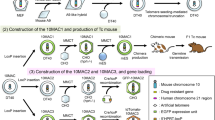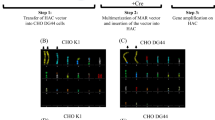Abstract
Human artificial chromosomes (HACs) segregating freely from host chromosomes are potentially useful to ensure both safety and duration of gene expression in therapeutic gene delivery. However, low transfer efficiency of intact HACs to the cells has hampered the studies using normal human primary cells, the major targets for ex vivo gene therapy. To elucidate the potential of HACs to be vectors for gene therapy, we studied the introduction of the HAC vector, which is reduced in size and devoid of most expressed genes, into normal primary human fibroblasts (hPFs) with microcell-mediated chromosome transfer (MMCT). We demonstrated the generation of cytogenetically normal hPFs harboring the structurally defined and extra HAC vector. This introduced HAC vector was retained stably in hPFs without translocation of the HAC on host chromosomes. We also achieved the long-term production of human erythropoietin for at least 12 weeks in them. These results revealed the ability of HACs as novel options to circumvent issues of conventional vectors for gene therapy.
This is a preview of subscription content, access via your institution
Access options
Subscribe to this journal
Receive 12 print issues and online access
$259.00 per year
only $21.58 per issue
Buy this article
- Purchase on Springer Link
- Instant access to full article PDF
Prices may be subject to local taxes which are calculated during checkout




Similar content being viewed by others
References
Thomas CE, Ehrhardt A, Kay MA . Progress and problems with the use of viral vectors for gene therapy. Nat Rev Genet 2003; 4: 346–358.
Larin Z, Mejia JE . Advances in human artificial chromosome technology. Trends Genet 2002; 18: 313–319.
Tomizuka K et al. Functional expression and germline transmission of a human chromosome fragment in chimaeric mice. Nat Genet 1997; 16: 133–143.
Tomizuka K et al. Double trans-chromosomic mice: maintenance of two individual human chromosome fragments containing Ig heavy and kappa loci and expression of fully human antibodies. Proc Natl Acad Sci USA 2000; 97: 722–727.
Kuroiwa Y et al. Manipulation of human minichromosomes to carry greater than megabase-sized chromosome inserts. Nat Biotechnol 2000; 18: 1086–1090.
Katoh M et al. Construction of a novel human artificial chromosome vector for gene delivery. Biochem Biophys Res Commun 2004; 321: 280–290.
Koi M, Morita H, Shimizu M, Oshimura M . Construction of mouse A9 clones containing a single human chromosome (X/autosome translocation) via micro-cell fusion. Jpn J Cancer Res 1989; 80: 122–125.
Killary AM, Fournier RE . Microcell fusion. Methods Enzymol 1995; 254: 133–152.
Klobutcher LA, Miller CL, Ruddle FH . Chromosome-mediated gene transfer results in two classes of unstable transformants. Proc Natl Acad Sci USA 1980; 77: 3610–3614.
de Jong G et al. Efficient in-vitro transfer of a 60-Mb mammalian artificial chromosome into murine and hamster cells using cationic lipids and dendrimers. Chromosome Res 2001; 9: 475–485.
Goodnough LT, Monk TG, Andriole GL . Erythropoietin therapy. N Engl J Med 1997; 336: 933–938.
Kuroiwa Y et al. Cloned transchromosomic calves producing human immunoglobulin. Nat Biotechnol 2002; 20: 889–894.
Shinohara T et al. Stability of transferred human chromosome fragments in cultured cells and in mice. Chromosome Res 2000; 8: 713–725.
Ikeno M, Masumoto H, Okazaki T . Distribution of CENP-B boxes reflected in CREST centromere antigenic sites on long-range alpha-satellite DNA arrays of human chromosome 21. Hum Mol Genet 1994; 3: 1245–1257.
Mills W, Critcher R, Lee C, Farr CJ . Generation of an approximately 2.4 Mb human X centromere-based minichromosome by targeted telomere-associated chromosome fragmentation in DT40. Hum Mol Genet 1999; 8: 751–761.
Saffery R et al. Construction of neocentromere-based human minichromosomes by telomere-associated chromosomal truncation. Proc Natl Acad Sci USA 2001; 98: 5705–5710.
Harrington JJ et al. Formation of de novo centromeres and construction of first-generation human artificial microchromosomes. Nat Genet 1997; 15: 345–355.
Ikeno M et al. Construction of YAC-based mammalian artificial chromosomes. Nat Biotechnol 1998; 16: 431–439.
Mejia JE et al. Functional complementation of a genetic deficiency with human artificial chromosomes. Am J Hum Genet 2001; 69: 315–326.
Fussenegger M et al. Controlled proliferation by multigene metabolic engineering enhances the productivity of Chinese hamster ovary cells. Nat Biotechnol 1998; 16: 468–472.
Vanderbyl S et al. Transfer and stable transgene expression of a mammalian artificial chromosome into bone marrow-derived human mesenchymal stem cells. Stem Cells 2004; 22: 324–333.
Lander ES et al. Initial sequencing and analysis of the human genome. Nature 2001; 409: 860–921.
Bartholomew A et al. Baboon mesenchymal stem cells can be genetically modified to secrete human erythropoietin in vivo. Hum Gene Ther 2001; 12: 1527–1541.
Ebert BL, Bunn HF . Regulation of the erythropoietin gene. Blood 1999; 94: 1864–1877.
Katoh K, Takahashi Y, Hayashi S, Kondoh H . Improved mammalian vectors for high expression of G418 resistance. Cell Struct Funct 1987; 12: 575–580.
Acknowledgements
We thank Drs I Ishida, T Mikayama and T Inoue-Nishida for comments and discussions. We also thank Ms M Takahashi and Mr F Ayabe for technical assistance. This study was partly supported by a Health and Labor Sciences Research Grant for Research into Human Genome and Tissue Engineering from the Ministry of Health, Labor and Welfare in Japan (MO, KT), and by the 21st Century COE program from the Ministry of Education, Culture, Sports, Science and Technology of Japan (MO, KT).
Author information
Authors and Affiliations
Rights and permissions
About this article
Cite this article
Kakeda, M., Hiratsuka, M., Nagata, K. et al. Human artificial chromosome (HAC) vector provides long-term therapeutic transgene expression in normal human primary fibroblasts. Gene Ther 12, 852–856 (2005). https://doi.org/10.1038/sj.gt.3302483
Received:
Accepted:
Published:
Issue Date:
DOI: https://doi.org/10.1038/sj.gt.3302483
Keywords
This article is cited by
-
Pluripotent stem cell-based gene therapy approach: human de novo synthesized chromosomes
Cellular and Molecular Life Sciences (2021)
-
Profiling the immunotoxicity of chemicals based on in vitro evaluation by a combination of the Multi-ImmunoTox assay and the IL-8 Luc assay
Archives of Toxicology (2018)
-
The soluble form of BMPRIB is a novel therapeutic candidate for treating bone related disorders
Scientific Reports (2016)
-
Retargeting of microcell fusion towards recipient cell-oriented transfer of human artificial chromosome
BMC Biotechnology (2015)
-
A pathway from chromosome transfer to engineering resulting in human and mouse artificial chromosomes for a variety of applications to bio-medical challenges
Chromosome Research (2015)



